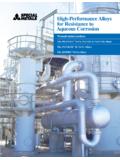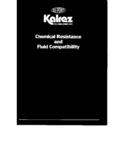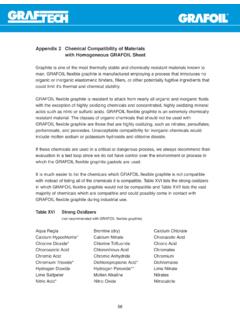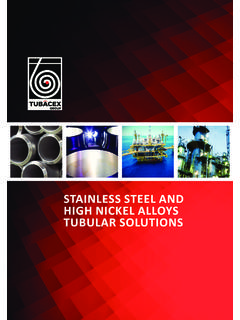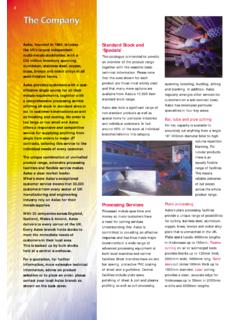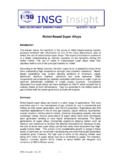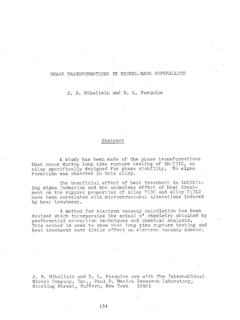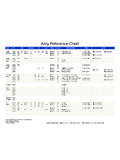Transcription of High-Performance Alloys for Resistance to …
1 63 Wrought nickel productsThe INCONEL Ni-Cr,Ni-Cr-Fe & Ni-Cr-Mo AlloysThe INCOLOY Fe-Ni-Cr AlloysThe MONEL Ni-Cu AlloysHigh- performance Alloysfor Resistance toAqueous CorrosionPublication number SMC-026 Copyright Special Metals Corporation, 2000 INCONEL, INCOLOY, MONEL, INCO-WELD, DURANICKEL,625 LCF, 686 CPT, 725, 864 and 925 are trademarks of the Special Metals group of Problems and Alloy Solutions1 Corrosion-Resistant Alloysfrom the Special Metals Group of Companies4 Alloy Selection forCorrosive Environments11 Corrosion by Acids12 Sulfuric Acid12 Hydrochloric Acid17 Hydrofluoric Acid20 Phosphoric Acid22 Nitric Acid25 Organic Acids26 Corrosion by Alkalies28 Corrosion by Salts31 Atmospheric Corrosion35 Corrosion by Waters37 Fresh and Process Waters37 Seawater and Marine Environments38 Corrosion by Halogensand Halogen Compounds40 Fluorine and Hydrogen Fluoride40 Chlorine at Ambient Temperature41 Chlorine and Hydrogen Chlorideat high Temperatures41 Metallurgical Considerations44 Appendix49 Corrosion Science and Electrochemistry50 References60 Special Metals Corporation to their excellent corrosion Resistance and good mechanical properties.
2 The Special Metals nickel -based Alloys are used for abroad range of applications in an equally broad range of industries,including chemical and petrochemical processing,pollution control,oil and gas extraction,marine engineering,power generation,andpulp and paper manufacture. The Alloys ' versatility and reliabilitymake them the prime materials of choice for construction of processvessels,piping systems,pumps,valves and many other applicationsdesigned for service in aqueous and high -temperature variables influence the performance of a specific materialin a specific environment. These include concentration,temperature,aeration,liqui d or gaseous flow rates,impurities,abrasives,andcycling process conditions. While every attempt has been made topresent a broad base of information,more detailed data will often be needed for individual applications and reader isencouraged to contact Special Metals marketing and technical stafffor more specific alloy properties and a wealthof experience ofapplications and alloy service and corrosion under aqueous conditions can takeplace by many mechanisms with quite varied brief general description of each type of corrosion is presented here as an introduction.
3 More detail of themechanics of the various types of corrosion is presentedlater in this publication under Corrosion Science andElectrochemistry .General Corrosion General corrosion is a uniformattack and is the most commonly encountered type of corrosion. It is characterized by a chemical or electro-chemical reaction which proceeds uniformly over theentire exposed surface area. The metal becomes thinnerand eventually Corrosion Conditions may exist that causecorrosive attack in a very specific location or under a specific set of conditions. Such attack is normally referredto as localized. This type of corrosion takes several ,crevice attack,and microbially influenced corrosion (MIC) are all types of localized Pitting is a form of very localized attack thatresults in the formation of holes in the metal. While theholes formed are generally small they can propagate veryquickly leading to material perforationand failure in a veryshort period of time.
4 The micro-environment within the pit itself can be autocatalytic making this a particularlydangerous form of problems can be found in many Corrosion Crevice attack usually takes placein a very tight gap between two surfaces ( as with gaskets or fasteners or under mineral deposits). As withpitting,the micro-environment within the crevice cangreatly differ from the general medium. Concentrationcells can cause this type of corrosion to progress at a very rapid Influenced Corrosion (MIC) MIC is a recently identified form of crevice attack. Certain typesof bacteria form dome-shaped colonies on the metallicsurface. The inside of the structure is sealed from the outside. The life cycle of the bacteria produces a corrosiveenvironment within the colony which causes a creviceattack of the metal. While MIC usually takes place oncomponents exposed to natural water (either fresh orbrackish),it has also been encountered in process water in industrial systems.
5 Environmentally Assisted Cracking Some types of corrosion take place as a result of chemical conditionswithin the environment and the mechanicalcondition of themetal itself. Both conditions must be present for this typeof corrosion to take place. Corrosion fatigue,stress corro-sion cracking,liquid metal cracking,and hydrogenembrittlement are all forms of environmentally assistedcracking. Corrosion Problems and Alloy Solutions2 Corrosion Fatigue Corrosion fatigue failure takesplace due to the reduction of fatigue Resistance of themetal with the presence of a corrosive medium. Thus it isnormally encountered not as a visible degradation of the metal but as a premature failure of a component undercyclic conditions. The stress under which the material fails would not normally be considered sufficient to cause Corrosion Cracking This refers to the crack-ing caused by the simultaneous presence of tensile stressand a specific corrosive medium.
6 During this type ofcracking,the metal is virtually unattacked over most ofthe surface while fine cracks progress through it at theattack site. Chloride stress cracking of stainless steels andammonia stress cracking of nickel -copper Alloys areexamples of this type of Metal Cracking Liquid metal cracking is aspecialized form of stress corrosion. The susceptiblemetal(usually due to residual tensile stresses from fabrication) is attacked (cracked) by a low-melting liquid metal. An example is the cracking of aged Ni-Cr-Fe Alloys by silver-base braze Embrittlement Hydrogen embrittlementtakes place due to the penetration of the surface of susceptible metals by elemental hydrogen. This can resultfrom the formation of metallic hydridecompounds insome materials while in others it takes place by the interaction of dissolved hydrogen atoms. Regardless of the mechanism,the attack results in the formation andpropagation of fine cracks and voids in the metallic Corrosion Intergranular corrosion,as the name implies,is the selective attack of a metalliccomponent at the grain boundaries by a corrosive medium.
7 Several conditions can lead to a material beingsusceptible to intergranular corrosion. In some environ-ments the grain boundary of a metal simply exhibits themost reactive nature. Because of thermal mechanical processing,metallic compounds may tend to precipitateand migrate to the grain these are more reac-tive than the metallic matrix,they can be selectivelyattacked. Metallic reactions can cause areas adjacent tothe grain boundary to be depleted of some element,rendering this zone less resistant to attack. A commonlyencountered form of intergranular corrosion is the attack of non-stabilized austenitic stainless steels due tothe formation of chromium carbide precipitatesand thesubsequent depletion of Corrosion Erosion corrosion is the accelera-tionor increase in rate of deterioration or attack on a metalbecause of relative movement between a corrosive mediumand the metal surface.
8 Generally the movement is rapidand the effects of mechanical wear or abrasion areinvolved. Metal is removed from the surface as dissolvedions or corrosion products are mechanically swept awayfrom the metal Corrosion Galvanic corrosion results fromthe electrical coupling of two dissimilar metals in a corro-sive medium resulting in the attack of the less resistantmetal. The metallic differences may be due to metallicstructure as well as composition. The less noble materialbecomes anodic while the more noble becomes anodic material actually protects the cathodic leadingto its own accelerated decay. Ranking of materials in anelectromotive force (EMF) or galvanic series in a specificmedia will help determine the propensity of two materialsfor this type of corrosion. The farther apart the materialsare in the series,the greater is the likelihood of attack ofthe less noble material. Dealloying Dealloying (also referred to as selectiveleaching) is the selective removal of one element of a solid alloy by a corrosion process.
9 A corrosive mediumspecifically attacks one component of the alloy. A common example of this type of corrosion is the selective removal of zinc from brass (dezincification). nickel retains an austenitic,face-centered-cubic (fcc) crystal structure up to its melting point,providing freedomfrom ductile-to-brittle transitions and minimizing the fabrication problems that can be encountered with othermetals. In the electrochemical series, nickel is more noblethan iron but more active than copper. Thus,in reducingenvironments, nickel is more corrosion resistant than iron,but not as resistantas copper. Alloying with chromiumprovides Resistance to oxidation thus providing a broadspectrum of Alloys for optimum corrosion Resistance inboth reducing and oxidizing environments. nickel -basedalloys have a higher tolerance for alloying elements insolid solution than stainless steels and other iron-basedThe solutions to the problemscan be found in nickel and its alloying but maintain good metallurgical stability.
10 These factors have prompted development of nickel -based alloyswith multiple alloying additions to provide Resistance to a wide variety of corrosive Provides metallurgical stability,improves thermal stability and weldability,improves Resistance toreducing acids and caustics,and increases resistancetostress corrosion cracking particularly in chlorides Improves Resistance to oxidizing corrosives and to high -temperature oxidation and sulfidation,and enhances Resistance to pitting and crevice Improves Resistance to reducing acids,and to pitting and crevice corrosion in aqueous chloridecontaining environments. It contributes to increased high -temperature Improves Resistance to high -temperature carburizing environments,reduces alloy costs,and controls thermal Improves Resistance to reducing acids (particularly non-aerated sulfuric and hydrofluoric) and tosalts.

